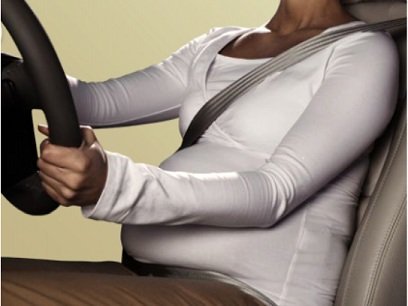10 Tips for Pregnant Drivers

Interactive Driving Systems in Britain has been researching global pharmaceutical companies' vehicle sales fleets - many of whose vehicles are driven by women.
That means a higher-than-normal percentage of pregnant women behind the wheel.
Always wear a three-point
"This led us," the organisation said, "to explore some of the gender issues in work-related road safety such as the risks of driving while pregnant."
Discussions with Professor Hank Weiss of the Dunedin School of Medicine in New Zealand, researchers said, suggested that a pregnant woman should always wear a lap/shoulder belt (three-point belt) with the lap section placed firmly beneath her belly and across her hips.
Weiss particularly acknowledged research by Beck et al (2005) focusing on seat-belt use among reproductive-aged women and pre-natal counselling on seat-belt use.
"We also discussed the risks of driving while pregnant with Roche Australia fleet manager Jann White," he added, "as the company has had fleet policy guidance which says (in Australia) that a pregnant woman is required by law to wear a seat belt.
"Correctly worn, this will help to protect both mother and unborn child."
Sash? Between breasts
The lap part of the belt should be positioned over the upper thighs and as comfortably as possible across the hips. The sash part of the belt should be placed between the breasts and the lap part securely fitted over the upper thighs.
Do not, the researchers say, place the horizontal section of the seat belt across the waist. "This is a significant risk that should be taken seriously to protect mother and baby."
Further research revealed 10 good practice tips for safe travel when pregnant:
1. Minimise the need to drive, especially as your pregnancy progresses and belly gets closer and closer to the steering wheel. If you must travel, plan the route to allow for safe breaks (toilet and leg-stretching) and let others know your travel plans. You should also think about your safety and comfort when entering and loading things into your vehicle.
2. Drive carefully. Collisions can be reduced significantly by pregnant women following general driving tips, such as refraining from tailgating by following the three-second rule, avoiding cellphone use, reducing speed and considering using public transport.
3. Wear your seat belt at all times. The belt will have no adverse effect on your pregnancy, though it may protect you and your child. When pregnant, allow the waist strap to rest below the bump, low and snug on your hipbones. The shoulder strap should slide effortlessly across the chest. Never wear the belt across or above your belly. Always use the shoulder belt, which should fit snugly between your breasts.
4. Position yourself correctly. Move your seat as far back as is comfortable and tilt it slightly away from the steering wheel. Try to position yourself at least 25cm from the steering wheel. Also, make sure the steering wheel is tilted toward your breastbone rather than toward your abdomen. Avoid leaning forward.
Sit back against the seat with as little slack in your belt as possible. This will keep your bump from hitting the bottom of the wheel, minimise your forward movement in a crash and let the air bag operate correctly. Air bags are sometimes blamed for causing bodily harm to the driver - while there's always a chance, you're far less likely to be injured if you've taken the proper air bag precautions.
5. If you're in a collision. Even if it's a minor one and you feel OK, have the baby's heartbeat checked to make sure no damage has been done. Even if you don't feel you've been hurt, research suggests that pregnant women in crashes without documented injuries are at greater risk of premature labour caused by a placental abruption.
6. Take regular breaks. It's important to keep healthy circulation, particularly in your legs. Take regular breaks, even if just for a couple of minutes, so you can stretch your legs.
7. Minimise driving at night. Night driving is exponentially more dangerous and not just for pregnant women. Night driving reduces visibility, increases the chance of encountering a drunk driver and increases fatigue.
8. Fill up before hitting the road. It is not just the car that needs to be kept topped up during a pregnancy. This is also essential for the mother-to-be behind the wheel. If you're pregnant, it's imperative to keep your blood sugar at a healthy level, and that you avoid eating unhealthy food. By eating before you leave the house, and packing some healthy snacks for the road, you can keep your blood sugar in check and eat healthily.
Drinking plenty of water is important and bottled water and fruit should be carried when travelling.
9. Prepare for health emergencies. Your health is at greater risk during pregnancy, which multiplies when you get behind the wheel. Packing a travel pillow, toiletries, fully-charged mobile phone and additional clothes is recommended. If you are far along in your pregnancy you could find these items particularly handy if birth comes earlier than expected.
10. Stop driving at the best time. As you get closer to your due date, it ' a good idea to reduce driving. Freedom, independence and your sales bonus are tough to give up but you should only drive when absolutely necessary. As you enter your third trimester, take a back seat to the safety of you and your child. Although there is no hard-and-fast rule, most women tend to stop driving around 30 weeks. You should also consider when to start driving again after giving birth.
Related News


